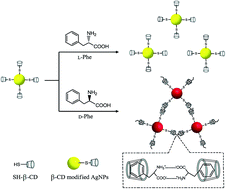β-Cyclodextrin-modified silver nanoparticles as colorimetric probes for the direct visual enantioselective recognition of aromatic α-amino acids†
Abstract
Efficient enantiomer discrimination by a convenient method remains a challenge in biochemical and pharmaceutical fields. Herein we have modified silver nanoparticles (AgNPs) with β-cyclodextrin (β-CD) to obtain a probe for the chiral recognition of aromatic α-amino acids. This assay relies on the distance-dependent optical properties of AgNPs and the difference in inclusion binding strength between the aromatic amino acid enantiomers and the β-CD host. The response of β-CD functionalized-AgNPs to certain chiral aromatic amino acid enantiomers namely D- and L-phenylalanine (Phe), D- and L-tryptophan (Trp), and D- and L-tyrosine (Tyr) in phosphate buffer solutions was studied in detail. In the presence of D-Phe (or L-Trp or L-Tyr), an appreciable yellow-to-red color change of the AgNP solution can be observed, whereas no color change is found in the presence of L-Phe (or D-Trp or D-Tyr). This method can be used to quantitatively determine the percentage of D-Phe in a mixture of D- and L-Phe. The chiral assay described in this work is easily readout with the naked eye or using a cheap UV-vis spectrometer. This method excels by its simplicity, low cost, and good availability of materials.


 Please wait while we load your content...
Please wait while we load your content...